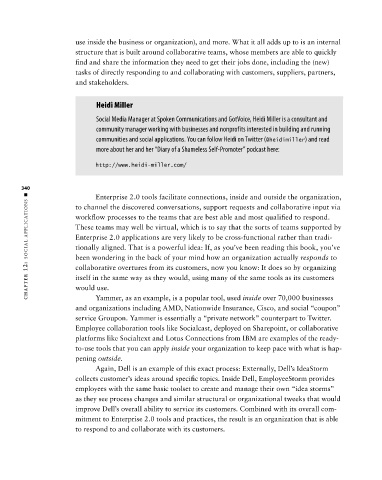Page 362 - Social Media Marketing
P. 362
chapter 12: SOCIAL APPLICATIONS ■use inside the business or organization), and more. What it all adds up to is an internal
structure that is built around collaborative teams, whose members are able to quickly
find and share the information they need to get their jobs done, including the (new)
tasks of directly responding to and collaborating with customers, suppliers, partners,
and stakeholders.
Heidi Miller
Social Media Manager at Spoken Communications and GotVoice, Heidi Miller is a consultant and
community manager working with businesses and nonprofits interested in building and running
communities and social applications. You can follow Heidi on Twitter (@heidimiller) and read
more about her and her “Diary of a Shameless Self-Promoter” podcast here:
http://www.heidi-miller.com/
340
Enterprise 2.0 tools facilitate connections, inside and outside the organization,
to channel the discovered conversations, support requests and collaborative input via
workflow processes to the teams that are best able and most qualified to respond.
These teams may well be virtual, which is to say that the sorts of teams supported by
Enterprise 2.0 applications are very likely to be cross-functional rather than tradi-
tionally aligned. That is a powerful idea: If, as you’ve been reading this book, you’ve
been wondering in the back of your mind how an organization actually responds to
collaborative overtures from its customers, now you know: It does so by organizing
itself in the same way as they would, using many of the same tools as its customers
would use.
Yammer, as an example, is a popular tool, used inside over 70,000 businesses
and organizations including AMD, Nationwide Insurance, Cisco, and social “coupon”
service Groupon. Yammer is essentially a “private network” counterpart to Twitter.
Employee collaboration tools like Socialcast, deployed on Sharepoint, or collaborative
platforms like Socialtext and Lotus Connections from IBM are examples of the ready-
to-use tools that you can apply inside your organization to keep pace with what is hap-
pening outside.
Again, Dell is an example of this exact process: Externally, Dell’s IdeaStorm
collects customer’s ideas around specific topics. Inside Dell, EmployeeStorm provides
employees with the same basic toolset to create and manage their own “idea storms”
as they see process changes and similar structural or organizational tweeks that would
improve Dell’s overall ability to service its customers. Combined with its overall com-
mitment to Enterprise 2.0 tools and practices, the result is an organization that is able
to respond to and collaborate with its customers.

